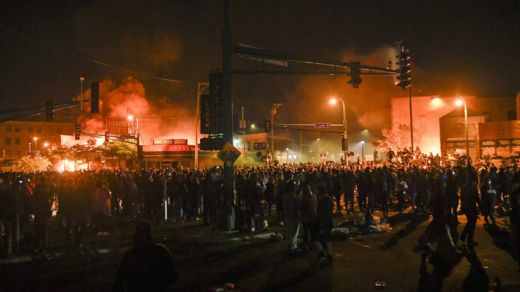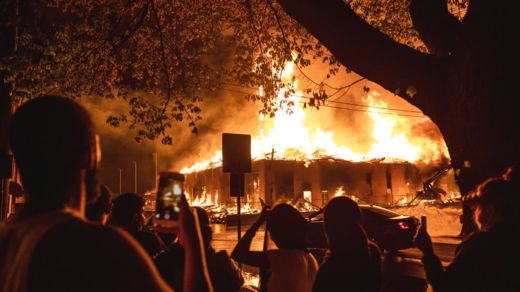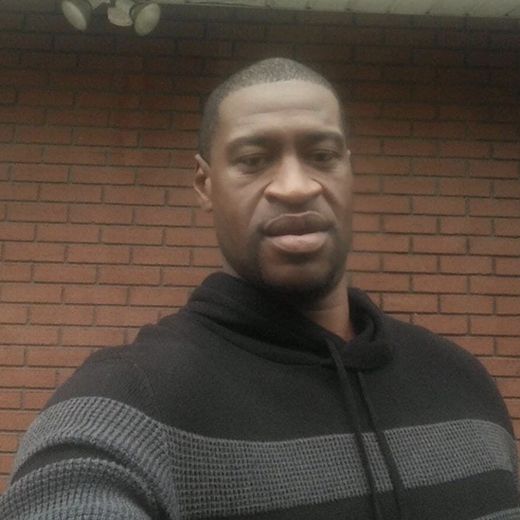A police station in Minneapolis has been set alight during a third night of protests over the death of an unarmed black man in custody.
The unrest continued despite the governor of Minnesota ordering the deployment of hundreds of members of the National Guard to restore order.
President Donald Trump said "thugs" were "dishonouring the memory" of George Floyd, 46, who died on Monday.
Video showed him gasping for breath as a white policeman knelt on his neck.
Mr Floyd's family have demanded the four police officers implicated in his death face murder charges. But prosecutors have said they are still gathering evidence.
The incident has added to longstanding anger over the police killings of black Americans, including the recent case of Breonna Taylor in Kentucky.
Protesters have also taken to the streets in Chicago, Los Angeles and Memphis.
What happened on Thursday night?

The last few days have seen multiple buildings burned to the ground or looted.
On Thursday, police officers fired tear gas and rubber bullets in an attempt to disperse a crowd outside the 3rd Precinct, the epicentre of the unrest.
But the cordon around the police station was eventually breached by protesters, who set fire to it and two other nearby buildings, as officers withdrew.
The Minneapolis Police Department said in a statement that the 3rd Precinct had been evacuated shortly after 22:00 "in the interest of the safety of our personnel".
Later, the city government tweeted that it had heard "unconfirmed reports that gas lines to the 3rd Precinct have been cut and other explosives materials are in the building". It urged people near the building to retreat for their own safety.Minnesota Governor Tim Walz activated the state's National Guard troops at the request of the mayors of Minneapolis and the neighbouring city of St Paul, declaring the situation a "peacetime emergency".
He said the looting, vandalism and arson of Wednesday night had resulted in damage to many businesses, including ones owned by minorities.
"George Floyd's death should lead to justice and systemic change, not more death and destruction," he said in a statement, calling on all protests to remain peaceful.
President Donald Trump blamed Thursday's violence on a "lack of leadership" in Minneapolis and warned that he would send in the National Guard and "get the job done right" if Mayor Jacob Frey failed to bring the city under control.
The White House press secretary said earlier that Mr Trump "was very upset" when he saw the footage of Mr Floyd's death, adding: "He wants justice to be served."
Mayor Frey called on Wednesday for criminal charges against the policeman who was filmed pinning down Mr Floyd. He and the three other officers involved in the arrest have already been fired.

The Minnesota police handbook states that officers trained on how to compress the neck without applying direct pressure to the airway can use a knee under its use-of-force policy. This is regarded as a non-deadly-force option.
The incident echoes the case of Eric Garner, who was placed in a police chokehold in New York in 2014. His death became a rallying cry against police brutality and a catalyst in the Black Lives Matter movement.
How have the protests unfolded?
They began in the afternoon on Tuesday, when hundreds of people came to the intersection where the incident had taken place.
Organisers tried to keep the protest peaceful and maintain coronavirus social distancing, with demonstrators chanting "I can't breathe" and "It could've been me".
During the second night of demonstrations on Wednesday, the crowd grew into the thousands, with protesters pelting rocks and some throwing tear-gas canisters back at police.
There was a standoff outside the police station where officers formed a human barricade to prevent protesters gaining entry.
What's the reaction?
Mr Floyd's brother, Philonise Floyd, told CNN on Thursday he hoped the officers involved got the death penalty.
"I'm never gonna get my brother back," he said. "We need justice."
Speaking through tears, he said the officers who "executed my brother in broad daylight" must be arrested and that he was "tired of seeing black men die".
He added that he understood why protesters were lashing out.
"I can't stop people right now because they have pain - they have the same pain that I feel."
Minneapolis Police Chief Medaria Arradondo apologised for the "pain, devastation and trauma" caused by Mr Floyd's death and said his department had contributed to "a deficit of hope" in the city.
United Nations human rights chief Michelle Bachelet has also condemned Mr Floyd's death, saying the role of "entrenched and pervasive racial discrimination" must be recognised and dealt with.
She called for protesters to act peacefully, and for police to "take utmost care not to inflame the current situation even more".

President Donald Trump "was very upset" when he saw the footage of Mr Floyd's death, White House press secretary Kayleigh McEnany told reporters on Thursday.
"He wants justice to be served."
A number of celebrities and athletes, including John Boyega, LeBron James, Beyonce, and Justin Bieber, have also expressed outrage over the incident.
What happened to George Floyd?
Officers responding to reports of the use of counterfeit money approached Mr Floyd in his vehicle on Monday.
According to police, he was told to step away from the car, physically resisted officers and was handcuffed. The police statement noted his apparent "medical distress".
Video of the incident does not show how the confrontation started.
A white officer can be seen using his knee to pin Mr Floyd to the ground by the neck as Mr Floyd groans "please, I can't breathe" and "don't kill me".
The city has identified the four officers involved as Derek Chauvin, Tou Thao, Thomas Lane and J Alexander Kueng.
Local media have named Mr Chauvin as the officer seen with his knee on Mr Floyd's neck.
The Minneapolis Police Officers Federation said the officers were co-operating with the investigation. In a statement to local media, the union said "now is not the time to rush to judgment".
"We must review all video. We must wait for the medical examiner's report."
One of the ex-officers - Derek Chauvin, 44 - had previously been involved in three other police shootings and had 17 complaints filed against him over his 19-year career, according to the Associated Press.
Latest Stories
-
Expansion Drive: Takoradi Technical University increases faculties
16 minutes -
SHS heads demand payment of outstanding funds before reopening of schools
52 minutes -
We thank God for the 2024 general elections – Akufo-Addo
1 hour -
Coconut Grove Beach Resort marks 30 years of excellence with memorable 9 lessons & carols service
1 hour -
WAFU B U-17 Girls’ Cup: Black Maidens beat Nigeria on penalties to win inaugral tournament
2 hours -
Real Madrid beat Sevilla to keep pressure on leaders Atletico
3 hours -
Liverpool put six past Spurs to go four points clear
3 hours -
Manchester United lose 3-0 at home to Bournemouth yet again
3 hours -
CHAN 2024Q: ‘It’s still an open game’ – Didi on Ghana’s draw with Nigeria
3 hours -
CHAN 2024Q: Ghana’s Black Galaxies held by Nigeria in first-leg tie
4 hours -
Dr Nduom hopeful defunct GN bank will be restored under Mahama administration
5 hours -
Bridget Bonnie celebrates NDC Victory, champions hope for women and youth
5 hours -
Shamima Muslim urges youth to lead Ghana’s renewal at 18Plus4NDC anniversary
6 hours -
Akufo-Addo condemns post-election violence, blames NDC
6 hours -
DAMC, Free Food Company, to distribute 10,000 packs of food to street kids
7 hours

